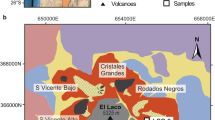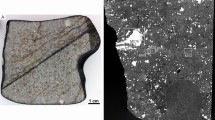Abstract
A metallographic and microprobe study was conducted on the H5 chondritic meteorite Richardton, using material that was free of terrestrial corrosion and ablation heating effects. Our observations indicate that initially well annealed and slowly cooled metal experienced an incomplete episode of discontinuous precipitation in the temperature range 350–400 °C, perhaps after mild deformation at some of the metal-silicate interfaces. There were no indications of externally imposed deformation after the 350 °C episode. The mechanism of discontinuous precipitation rather than plane interface growth has implications for the rate of formation of the metallographic structures, and the apparent temperature of this final heat treatment has implications for proposed reheating events identified by isotopic measurements of the silicate minerals that accompany the metal in this meteorite.
This is a preview of subscription content, access via your institution
Access options
Subscribe to this journal
Receive 51 print issues and online access
$199.00 per year
only $3.90 per issue
Buy this article
- Purchase on Springer Link
- Instant access to full article PDF
Prices may be subject to local taxes which are calculated during checkout
Similar content being viewed by others
References
Hey, M. H. Catalogue of Meteorites (British Museum, London, 1966).
Van Schmus, W. R. & Wood, J. A. Geochim. cosmochim. Acta 31, 747 (1967).
Dodd, R. T. Geochim. cosmochim. Acta 33, 161 (1969).
Affiatalab, F. & Wasson, J. Geochim. cosmochim. Acta, 44, 431 (1980).
Sears, D. W. & Axon, H. J. Nature 260, 34 (1976).
Turner, G., Enright, M. C. & Cadogan, P. H. Proc. 9th Lunar planet. Sci. Conf. 989 (1978).
Evensen, N. M., Carter, S. R., Hamilton, P. J., O'Nions, R. K. & Ridley, W. I. Earth planet. Sci. Lett. 42, 223 (1979).
Bevan, A. W. R. & Axon, H. J. Earth planet. Sci. Lett. 47, 353 (1980).
Gust, W. Phase Transformations Ser. 3, No. 11, Ch. 1,11 (The Institution of Metallurgists, London, 1979).
Williams, D. B. & Butler, E. P. Int. Metal. Rev. No. 3, 153 (1981).
Hutchison, R., Bevan, A. W. R., Easton, A. J. & Agrell, S. O. Proc. R. Soc. A374, 159 (1981).
Romig, A. D. & Goldstein, J. I. Geochim. cosmochim. Acta 45, 1187 (1981).
Brentnall, W. D. & Axon, H. J. J. Iron Steel Inst. 200, 947 (1962).
Buchwald, V. F. Handbook of Iron Meteorites Vol. 1, 131–136 (University of California Press, Berkeley, 1975).
Author information
Authors and Affiliations
Rights and permissions
About this article
Cite this article
Axon, H., Grokhovsky, V. Discontinuous precipitation reaction in the metal of Richardton chondrite. Nature 296, 835–837 (1982). https://doi.org/10.1038/296835a0
Received:
Accepted:
Published:
Issue Date:
DOI: https://doi.org/10.1038/296835a0
This article is cited by
-
Plessite formation by discontinuous precipitation reaction from γ-Fe,Ni in Richardton (H5) ordinary chondrite
Nature (1983)
-
Discontinuous precipitation reactions in ? and ? phases of meteoritic metal
Journal of Materials Science Letters (1982)
Comments
By submitting a comment you agree to abide by our Terms and Community Guidelines. If you find something abusive or that does not comply with our terms or guidelines please flag it as inappropriate.



